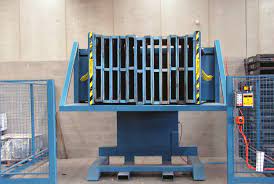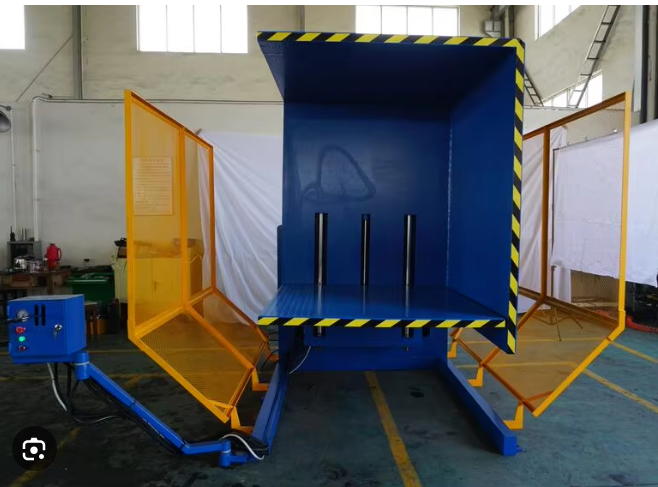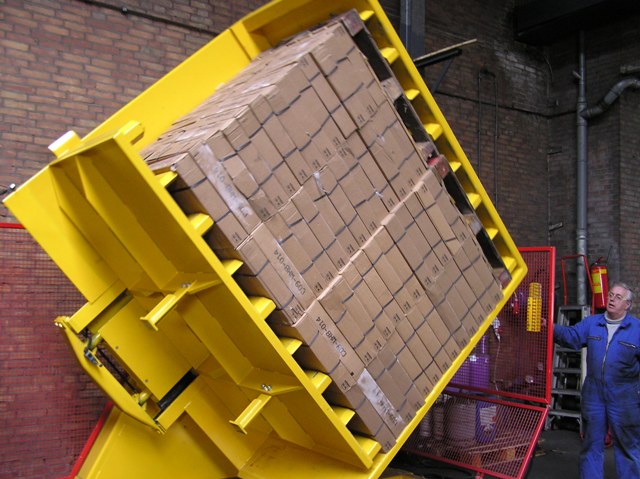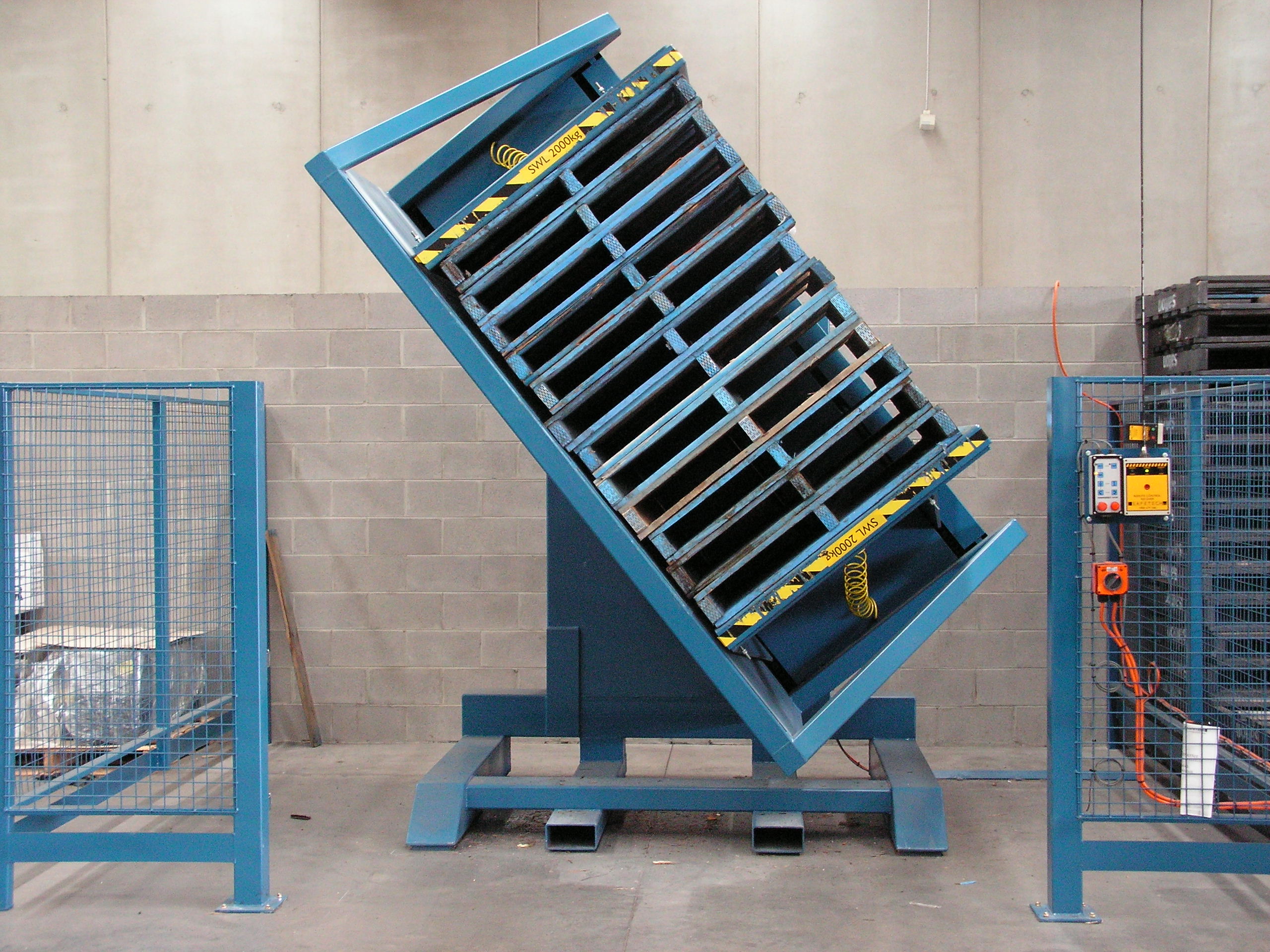Pallet Inverter: How to Change ESD-Safe Pallets in Chip Fabrication?
In a high-stakes environment like chip fabrication, the smallest detail can have massive consequences. You have products worth millions on a single pallet, and the entire process happens in a cleanroom where a single speck of dust can ruin everything. But your materials arrive from the warehouse on standard wooden or plastic pallets, which are forbidden inside. This creates a critical bottleneck. How do you safely and cleanly transfer these sensitive, heavy loads onto a specialized, ESD-safe pallet without risking contamination or damage? The manual process is slow, requires multiple staff, and is a recipe for disaster. One slip could cost you a fortune and halt production. The pressure to get it right every time is immense. This is where a pallet inverter provides an elegant and essential solution.
A pallet inverter is a piece of equipment designed to securely clamp a fully loaded pallet, rotate it 180 degrees, and allow for the easy exchange of pallets. In chip fabrication, this process is used to switch from a standard warehouse pallet to a specialized, cleanroom-compliant Electrostatic Discharge (ESD)-safe pallet. The machine gently clamps the product load, inverts it, and allows the operator to remove the old pallet from the top. Then, the new ESD-safe pallet is placed on the load, and the machine rotates back 180 degrees, setting the product down safely on its new, clean pallet, ready for the fabrication area.

This process sounds straightforward, but the technology and the stakes are anything but simple. The choice of machine, the features it includes, and how it integrates into your workflow can make the difference between a seamless operation and a constant headache. I've spent my career solving material handling problems, first as an engineer and now as a factory owner. While my daily focus is on steel coils and heavy industrial packing, the core principles are universal: efficiency, safety, and protecting the value of the product. Let's dive deeper into how this critical piece of equipment works and what you need to consider.
What Are the Key Features to Look for in a Pallet Inverter for Cleanrooms?
You've identified the need for a pallet inverter, but you quickly realize that a standard model from a warehouse catalog simply won't work for a cleanroom environment. A regular machine, with its painted steel and exposed hydraulic lines, would be a contamination nightmare, shedding particles and risking fluid leaks. Imagine investing in a piece of equipment only to have your quality control manager forbid it from ever entering the facility. It's a costly mistake that wastes both time and capital. The solution is to source a machine specifically engineered for sterile and sensitive environments, one that meets the strict standards of your industry.
When selecting a pallet inverter for a cleanroom, the most critical features to look for are stainless steel construction (typically 304 grade or higher), fully enclosed mechanisms to prevent particle shedding, smooth and non-porous surfaces for easy sterilization, and compliance with cleanroom classifications like ISO 14644. Many high-spec models will also use electric-powered drives instead of hydraulics to completely eliminate the risk of fluid contamination.

Deeper Dive: Material Science and Contamination Control
The choice of materials and design is not just a suggestion; it's a fundamental requirement dictated by the physics of cleanroom operation. Let's break down why these features are non-negotiable.
Stainless Steel vs. Standard Steel
A standard pallet inverter is usually made from carbon steel and then painted. For a general warehouse, this is perfectly fine. But in a cleanroom, paint can chip, and any scratch that exposes the steel underneath can lead to rust. Both rust and paint chips are considered major contaminants. Stainless steel, particularly grade 304, is the industry standard because it's inherently corrosion-resistant. It doesn't need a coating. Its surface is stable and won't shed particles into the air. For even more demanding applications, like those involving harsh cleaning chemicals, 316-grade stainless steel might be required for its superior corrosion resistance. This focus on material integrity reminds me of selecting the right steel for a heavy-duty coil car in a steel mill. In that case, you need high tensile strength and abrasion resistance to handle a 30-ton coil. In a cleanroom, you need chemical and particulate stability. The environment is different, but the principle is identical: the material must be perfectly matched to the operational challenge.
Enclosed Drives: Electric vs. Hydraulic
Traditional pallet inverters often use hydraulic systems because they are powerful and cost-effective. However, they also carry the risk of leaks. A single drop of hydraulic fluid in a cleanroom can compromise an entire production area, leading to a shutdown and extensive cleanup. To eliminate this risk, cleanroom-specific pallet inverters are often designed with electric-powered screw drives or motor-driven systems. All moving parts, gears, and motors are completely sealed within the machine's stainless steel body. This ensures that no lubricants or particles generated by the mechanical action can escape into the environment. It’s a design philosophy of total containment, which any manager concerned with quality, like Javier, would appreciate. He deals with dust and debris in his steel mill, and while the contaminant is different, the strategy of containment and control is the same.
| Feature | Primary Benefit for Chip Fab | Why It Matters | Parallel in Heavy Industry (e.g., Steel Mill) |
|---|---|---|---|
| SS304/316 Stainless Steel | Prevents rust and particle shedding. | Ensures no foreign material contaminates the wafers. | Heavy-Gauge Carbon Steel; resists deformation and impact from heavy coils. |
| All-Electric Drive System | Eliminates risk of hydraulic fluid leaks. | Protects the sterile environment from chemical spills. | Robust, Shielded Hydraulics; provides immense lifting power while guards protect lines from damage. |
| Smooth, Crevice-Free Surfaces | Allows for effective and easy cleaning/sterilization. | Prevents microbes or particles from accumulating in joints. | Easy-Access Maintenance Panels; allows for quick lubrication and inspection of critical components. |
| Sealed Mechanical Components | Contains any internally generated particles (e.g., from gears). | Maintains the cleanroom's air quality standards. | Dust Control Systems (e.g., baghouses); captures process-generated dust to protect workers and equipment. |
How Does a Pallet Inverter Improve ROI in Chip Manufacturing?
A specialized, cleanroom-certified pallet inverter is a significant capital expenditure. When you're looking at the price tag, it's easy to question the investment. How can you justify this cost, especially when there are so many other demands on your budget? You might be tempted to stick with a manual process, thinking you're saving money. But this is a classic false economy. The hidden costs of manual handling—in labor, in damaged product, and in production delays—add up quickly. A proper financial analysis reveals that the right machine doesn't cost money; it makes money by solving expensive problems.
A pallet inverter directly improves Return on Investment (ROI) in chip manufacturing by automating a slow, labor-intensive process, which cuts down on wage costs. It drastically minimizes the risk of dropping or damaging extremely high-value products during the transfer. This reduction in potential scrap alone can often justify the investment. Furthermore, it accelerates material flow into the cleanroom, boosting overall throughput and ensuring compliance with quality standards, which prevents costly batch rejections and production halts.

Deeper Dive: Quantifying the Financial Impact
For a practical leader like Javier, who scrutinizes every investment for its return, a vague promise of "improvement" isn't enough. You need to see the numbers. Let's break down the ROI into concrete, measurable components.
Labor Cost Reduction
Consider a manual pallet transfer. It typically requires at least two, sometimes three, workers to carefully de-stack and re-stack a pallet layer by layer. This can take anywhere from 15 to 30 minutes per pallet. With a pallet inverter, a single operator can complete the entire process in under 3 minutes.
Let's do some simple math:
- Manual Method: 2 workers x $30/hour x 0.25 hours/pallet = $15 per pallet.
- Pallet Inverter Method: 1 worker x $30/hour x 0.05 hours/pallet = $1.50 per pallet.
That's a savings of $13.50 per pallet. If your facility processes 20 pallets a day, that's a saving of $270 per day, or nearly $70,000 per year in direct labor costs alone. When I talk with clients in the steel industry about automated strapping systems, we do the exact same calculation. The principle is the same: automate the repetitive, time-consuming tasks to free up your skilled workers for more valuable jobs.
Product Damage and Scrap Prevention
This is often the biggest and most compelling factor. A single pallet of semiconductor wafers can be worth hundreds of thousands, or even millions, of dollars. The risk of human error during a manual transfer is always present. A dropped box or a damaged edge on a single wafer can have huge financial consequences. A pallet inverter clamps the load securely with controlled, even pressure before it ever moves. The risk of dropping the product is virtually eliminated. If the machine prevents just one major accident over its entire lifespan, it has likely paid for itself many times over. This is the same logic we apply to coil protection. A damaged steel coil has to be scrapped or sold at a discount, representing a huge loss. A $50,00 a coil tipper that prevents that damage is an easy investment decision.
| ROI Driver | How It's Measured | Financial Impact | Steel Industry Analogy |
|---|---|---|---|
| Reduced Labor | Time per pallet transfer; Number of staff required. | Annual savings on wages and benefits. | Automated coil banding vs. manual banding. |
| Damage Prevention | Reduction in scrap rate (%). | Avoided cost of lost product; insurance premium reduction. | Using coil tilters to prevent edge damage. |
| Increased Throughput | Pallets transferred per hour/shift. | Increased production capacity without adding shifts. | High-speed overhead cranes for faster loading. |
| Worker Safety/Ergonomics | Reduction in lifting-related injuries and claims. | Lowered workers' compensation costs; improved morale. | Eliminating manual lifting of heavy chains/tools. |
What Are the Installation and Maintenance Requirements for an ESD Pallet Changer?
You've done the financial analysis and selected the perfect cleanroom-rated pallet inverter. The machine is on its way. But the project is far from over. Installing a large piece of equipment into a highly controlled cleanroom environment presents its own set of challenges. A poorly planned installation can disrupt production, compromise the sterile environment, and cause long-term operational headaches. Likewise, once it's running, you can't just forget about it. Neglecting maintenance on a critical piece of equipment is like ignoring a warning light on your car's dashboard—it will eventually lead to a breakdown, and always at the worst possible time.
Installing an ESD pallet changer requires careful site preparation, including ensuring the floor can support the weight, providing the correct power supply, and integrating it seamlessly into the material airlock or entry point of the cleanroom. Maintenance is critical and involves a strict schedule of regular cleaning with approved non-contaminating solvents, inspection of all seals and safety sensors, and periodic calibration of the clamping pressure to ensure it handles products securely but gently.

Deeper Dive: From Factory Floor to Cleanroom Floor
Success depends on planning for the machine's entire lifecycle, from the moment it leaves the manufacturer to its daily operation for years to come.
The Importance of FAT and SAT
In my experience manufacturing equipment, the most successful projects always include two key milestones: the Factory Acceptance Test (FAT) and the Site Acceptance Test (SAT).
- FAT (Factory Acceptance Test): Before the machine ever ships from my factory, the client comes to us. We run the machine with their actual product types or a close simulation. We test every function, every sensor, every emergency stop. This is where we catch 95% of potential issues. For a leader like Javier, who understands machinery, this step provides immense confidence and prevents costly surprises. It’s much cheaper to adjust a machine in the factory than it is on-site.
- SAT (Site Acceptance Test): After the machine is installed at the client's facility, we repeat the tests. This confirms that nothing was damaged during shipping and that the machine performs correctly with the actual power supply and within the specific site conditions. This final check is the official handover and the start of the warranty period. Skipping these steps is a gamble I never recommend.
Developing a Proactive Maintenance Protocol
You cannot afford downtime. This means maintenance must be proactive, not reactive. A good supplier will provide a detailed maintenance schedule. This isn't just a suggestion; it should be integrated into your facility's Computerized Maintenance Management System (CMMS).
- Daily/Weekly: Visual inspection for any signs of wear, and cleaning all surfaces with approved cleanroom wipes and isopropyl alcohol (IPA) or other specified solvents.
- Quarterly: Check and test all safety features, including light curtains and emergency stops. For electric models, inspect motor brushes and connections. For hydraulic models (if used outside the cleanroom), check for any leaks and fluid levels.
- Annually: A more thorough service, often performed by a certified technician. This includes checking the calibration of the clamping pressure sensors, lubricating sealed internal components with cleanroom-grade grease, and inspecting all structural welds and fasteners.
Having a small stock of critical spare parts on-hand, like a key sensor or fuse, is also a wise strategy that I always recommend. For Javier's aging equipment, having a critical spares strategy is essential to maintaining uptime. The principle is the same for a brand-new pallet inverter.
My Insights: Why a Strategic Partnership Matters More Than the Machine Itself
Over the years, I've sold equipment to hundreds of companies, from small workshops to massive industrial complexes. And I've learned a powerful lesson, one that I built my own company, SHJLPACK, around. You can look at a catalog and buy a machine with the right specifications at a low price. But what happens when you have a unique challenge that isn't in the brochure? What happens when you need to integrate that machine with your new MES system? Or when a critical sensor fails at 3 AM on a Saturday? A faceless vendor who just sold you a box won't answer that call. This is where the real value lies, and it’s what a pragmatic leader like Javier looks for.
A true strategic partner provides far more than just a piece of hardware. They invest time to understand your entire operation. They bring deep application expertise to help you select, and sometimes even customize, the perfect machine. They provide comprehensive support through installation and training, and they remain available for ongoing advice on maintenance, upgrades, and how to integrate that equipment into your broader goals, like digitalization and cost reduction.

Deeper Dive: Seeing the Bigger Picture
When I transitioned from being an employee engineer to starting my own factory, I learned that a cheap machine that causes downtime is the most expensive machine you can possibly buy. The initial purchase price is only a small part of the total cost of ownership. For a steel mill owner like Javier, managing a complex, high-capital operation, this principle is magnified a thousand times over. The cost of a single hour of lost production in his mill likely exceeds the cost of many pieces of auxiliary equipment.
The challenges we've discussed in chip fabrication—precision, uptime, contamination control—are simply specialized versions of the challenges faced in every advanced manufacturing sector, including steel.
- An ESD pallet inverter is a precise solution for a material transition problem in a cleanroom.
- A coil upender is a robust solution for a material orientation problem in a steel plant.
- An automated coil wrapping line is a high-speed solution for a product protection and logistics problem.
In every case, the machine is a tool to solve a larger process issue. The conversation shouldn't start with, "How much does this machine cost?" It should start with, "What is the true cost of our current problem?"
This is the entire philosophy behind SHJLPACK. My mission is not just to sell equipment. It is to be a knowledge-sharing platform, to give back to the industry that has given me so much. When a client approaches me, I see a partner. I want to understand their goals and their pain points. If Javier were to call me about his challenges—high energy costs, aging equipment, the push for digitalization—we would have a strategic conversation. We would discuss how intelligent, automated packing and handling systems can reduce labor costs, protect product quality, and provide valuable data for his MES platform.
Whether we are discussing a pallet inverter for a cleanroom or a coil packing line for a steel mill, the core need is the same: finding a reliable, knowledgeable partner who is invested in your success. The machine is just the outcome of that successful partnership.
Conclusion
Ultimately, selecting the right pallet inverter, or any critical equipment, is about finding a trustworthy partner who understands your unique operational challenges and is committed to helping you achieve your goals.


